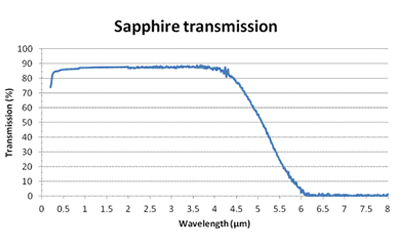Sapphire windows have excellent optical performance and physical properties. They are commonly used as protective windows for sensors and detectors, without altering the system's magnification.
Sapphire windows have the following main characteristics:
1. High Transmittance: They exhibit good transmittance in the 0.20 to 5.50 μm wavelength range. The infrared transmittance is almost unaffected by temperature changes, and they also have high transmittance for ultraviolet and visible light.
2. High Hardness: Uncoated sapphire has excellent surface hardness, with a transmittance range extending from ultraviolet to mid-infrared wavelengths. It is resistant to high temperatures, has good thermal conductivity, high hardness, infrared transmittance, and good chemical stability.
3. Corrosion Resistance: Sapphire windows are highly resistant to corrosion, making them suitable for harsh conditions, including high temperatures, high pressure, strong vacuum environments, or corrosive environments.
4. High Strength: They have high compressive strength and are more durable than standard optical glass.
Sapphire windows are widely used in various fields such as industry, defense, and scientific research. Applications include high-temperature infrared windows, substrate materials for the growth of GaN epitaxial layers in third-generation semiconductor materials, and optical systems in harsh environments, providing stable performance and protection.

Specifications | Commercial spec. | High precision spec. |
Material | Germanium | |
Dimension | 5mm~100mm | |
Dimension tolerance | ±0.1mm | ±0.05mm |
Surface quality | 60/40 | 20/10 |
Surface flatness | 1/4λ | 1/10λ |
Clear aperture | >85% of dim | >90% of dim |
Angel tolerance | 3 arc min | 5 arc sec. |
Parallelism | <1 arc min | <30 arc sec. |
Bevel | <0.2mm x 45deg | <0.1mm x 45deg |
Coating | Up on clients’ request | |
